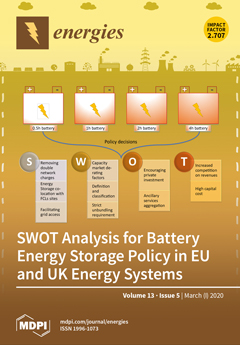Decarbonization of energy-intensive systems (e.g., heat and power generation, iron, and steel production, petrochemical processes, cement production, etc.) is an important task for the development of a low carbon economy. In this respect, carbon capture technologies will play an important role in the
[...] Read more.
Decarbonization of energy-intensive systems (e.g., heat and power generation, iron, and steel production, petrochemical processes, cement production, etc.) is an important task for the development of a low carbon economy. In this respect, carbon capture technologies will play an important role in the decarbonization of fossil-based industrial processes. The most significant techno-economic and environmental performance indicators of various fossil-based industrial applications decarbonized by two reactive gas-liquid (chemical scrubbing) and gas-solid CO
2 capture systems are calculated, compared, and discussed in the present work. As decarbonization technologies, the gas-liquid chemical absorption and more innovative calcium looping systems were employed. The integrated assessment uses various elements, e.g., conceptual design of decarbonized plants, computer-aided tools for process design and integration, evaluation of main plant performance indexes based on industrial and simulation results, etc. The overall decarbonization rate for various assessed applications (e.g., power generation, steel, and cement production, chemicals) was set to 90% in line with the current state of the art in the field. Similar non-carbon capture plants are also assessed to quantify the various penalties imposed by decarbonization (e.g., increasing energy consumption, reducing efficiency, economic impact, etc.). The integrated evaluations exhibit that the integration of decarbonization technologies (especially chemical looping systems) into key energy-intensive industrial processes have significant advantages for cutting the carbon footprint (60–90% specific CO
2 emission reduction), improving the energy conversion yields and reducing CO
2 capture penalties.
Full article





